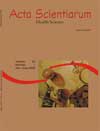Antihypertensive medicine prescription in basic unit of health in Maringá-Paraná
Abstract
In this study, carried out in the integrated health nucleus-NIS II - Mandacaru Maringá-PR, a basic unit of health, the prescription of antihypertensive drugs (FAH) was characterized (FAH). The quality of the prescription was evaluated through the number of drugs contained in each prescribed medication and also trough the agreement of these medications with two lists of medications: the one of essential medications of the State Basic Pharmacy and that one of the Secretaria Municipal de Saúde, municipality of Maringá (SMSM). The antihypertensive drugs prescribed were in accordance with the lists of the state basic pharmacy and SMSM (95,3%). The drugs were in higher frequency prescribed in monotherapy, 46,2%, and also in association of two drugs, 46,4%, of FAH. For 80,3% of the users of antihypertensive medicines, the reason of the consultation or complaint was the need of the medication to control arterial pressure. The pharmacological class of highest frequency was that of diuretics (48,1%), and the hydrochlorothiazide prescription was of 41,7%. We observed that the standard prescription of FAH provided a variety of information and problems referring to their use. On the other hand, we verified that the prescription of these medications in this health unit was in agreement with the therapeutics indicated for the treatment of arterial hypertension.Downloads
Download data is not yet available.
Published
2008-07-17
How to Cite
Tasca, R. S., Soares, D. A., & Cuman, R. K. N. (2008). Antihypertensive medicine prescription in basic unit of health in Maringá-Paraná. Acta Scientiarum. Health Sciences, 21, 383-387. https://doi.org/10.4025/actascihealthsci.v21i0.4452
Issue
Section
Health Sciences
DECLARATION OF ORIGINALITY AND COPYRIGHTS
I Declare that current article is original and has not been submitted for publication, in part or in whole, to any other national or international journal.
The copyrights belong exclusively to the authors. Published content is licensed under Creative Commons Attribution 4.0 (CC BY 4.0) guidelines, which allows sharing (copy and distribution of the material in any medium or format) and adaptation (remix, transform, and build upon the material) for any purpose, even commercially, under the terms of attribution.
Read this link for further information on how to use CC BY 4.0 properly.























5.png)







